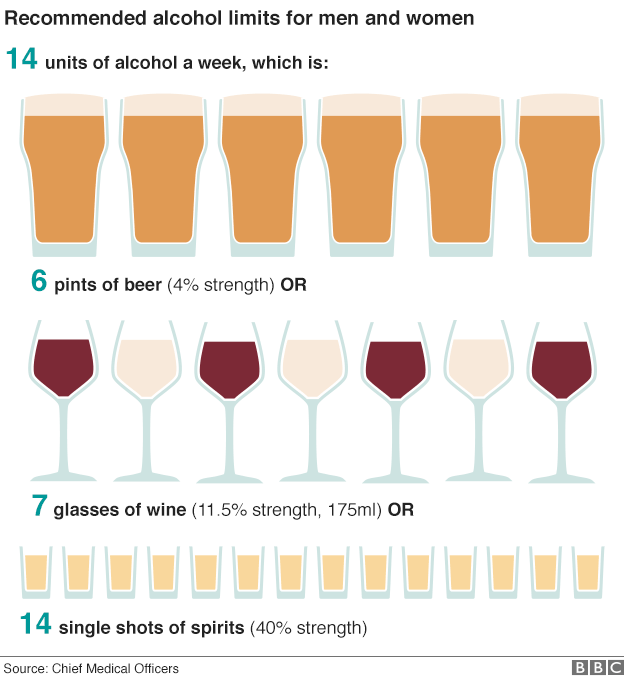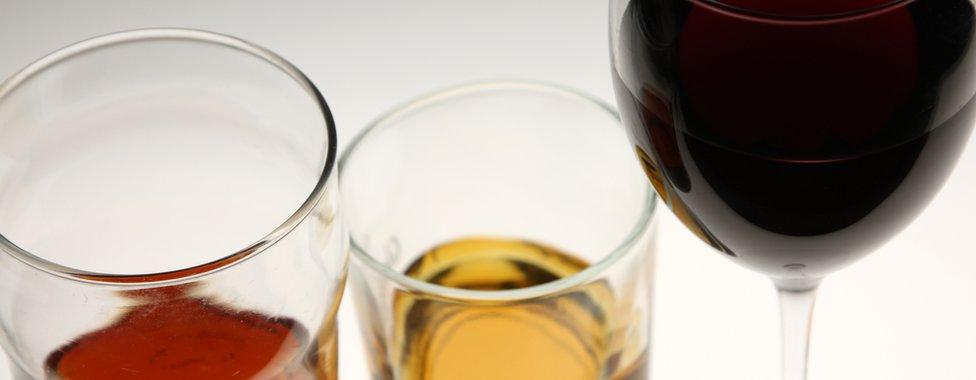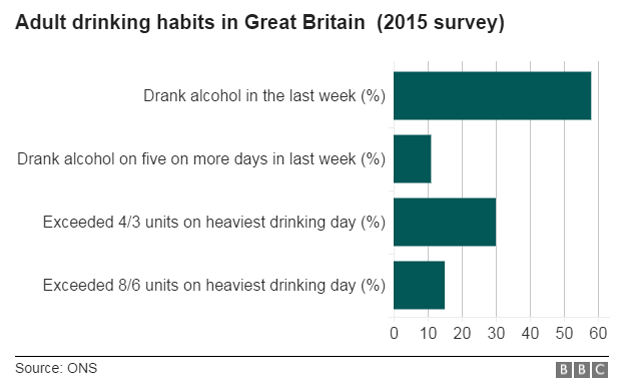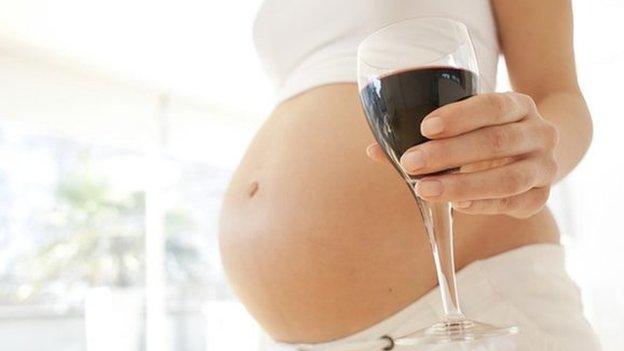Alcohol limits cut to reduce health risks
- Published
- comments
New alcohol guidelines: Are you drinking more than you think?
Tough new guidelines issued on alcohol have cut recommended drinking limits and say there is no such thing as a safe level of drinking.
The UK's chief medical officers say new research shows any amount of alcohol can increase the risk of cancer.
The new advice says men and women who drink regularly should consume no more than 14 units a week - equivalent to six pints of beer or seven glasses of wine.
Pregnant women should not drink at all.
It also says if people drink, it should be moderately over three or more days and that some days should be alcohol-free.
Nor should people "save up" their units and drink them all in one or two goes. Heavy drinking sessions increase the risk of accidents and injury, it says.
Low-level drinking
The guidance marks the first full review of alcohol guidelines since 1995, although updated advice on drinking in pregnancy and for young people was published in 2007 and 2009 respectively.
In relation to pregnant women, the new guidelines bring the rest of the UK in line with Scotland and recommend that pregnant women should not drink at all.
It marks a subtle shift from previous guidance for people in England, Wales and Northern Ireland which, while suggesting they should not drink, said that if they did, it should be no more than one or two units of alcohol once or twice a week, and they should not get drunk.

How the advice has changed
Previous government guidance set out daily drinking limits of three to four units for men and two to three for women. The new guidance moves to weekly limits to get away from the idea that drinking every day is fine.
The new 14 units limit therefore represents a cut in drinking levels for both men and women, although since 1995 doctors' groups have been advising that over the course of a week men should limit themselves to 21 units and women 14 units - the lower end of the daily range the government has been advising. So in effect the government guidance has caught up with the medical advice - and gone a bit further.
On drinking in pregnancy, the new advice is unambiguous. Women should not drink. Previously women in Wales, Northern Ireland and England had been told not to drink but if they did to limit it.
The latest guidance makes it clear people should be teetotal on some days and that heavy drinking sessions should be avoided. The 1995 guidelines did not set this out categorically.
Want to know more?

The old advice suggested that men should drink no more than three to four units a day and women two to three, with a 48-hour break after heavy drinking sessions.
But now the guidance does not differentiate between men and women, reducing recommended intake to 14 units across the whole week. The fear was that by having a daily limit it suggested it was alright to drink every day.
The guidance makes it clear that should not happen, and there are no safe drinking levels - with the exception that women over the age of 55 can get some benefit to their hearts from a small amount of drinking of up to five units a week.

Some studies have suggested low-level drinking could protect men from heart disease but the guidance says this is no longer the case.
This is likely to be down to an over-estimation of the benefits of drinking and the fact that society has got better at preventing heart disease.
Another major factor in the new guidance is the evidence that has been found in terms of alcohol increasing the risk of cancer.
It says the evidence suggests the risk of a range of cancers, such as mouth, throat and breast, increases with any amount you drink on a regular basis.
It says the links with cancer were not properly understood in 1995.
The new recommendations mean the UK has tougher limits for alcohol intake when compared to other European countries such as Demark, France, Spain and Italy - which all allow both men and women to drink more units of alcohol per week.

How many units of alcohol are in each drink?

Single shot of spirits (25ml): 1 unit
Standard (175ml) glass of wine: 2.1 units
Large (250ml) glass of wine: 3 units
Pint of 4%-strength beer: 2.3 units
Pint of 5%-strength beer: 2.8 units
Pint of strong cider (8%): 4.5 units

The 14-unit limit has been chosen because at that point, your drinking leads to a 1% risk of dying from alcohol-related causes.
This has been deemed to be an acceptable level of risk as it is approximately the same risk that someone has when they do an every day task such as driving a car.
'Informed decisions'
England's Chief Medical Officer, Dame Sally Davies, said: "Drinking any level of alcohol regularly carries a health risk for anyone, but if men and women limit their intake to no more than 14 units a week it keeps the risk of illness like cancer and liver disease low."
She added the aim of the guidelines was to give the public the most up-to-date scientific information to allow them to make "informed decisions" about their drinking.

Prof Sir Ian Gilmore, chair of the Alcohol Health Alliance, said the new advice was much-needed.
"People have a right to know the risks associated with drinking alcohol.
"Only with accurate and transparent information are people able to make an informed choice about how much alcohol they consume."
Prof Sir David Spiegelhalter, an expert in understanding risk from the University of Cambridge, said it was important to put the 1% risk in context. He said an hour of TV watching or a bacon sandwich a couple of time a week was more dangerous.
"It all seems to come down to what pleasure you get from moderate drinking," he added.
Meanwhile, the Portman Group, which speaks for the drinks industry, said the UK was breaking with established international precedent by recommending the same guidelines for men and women.
"It also means that UK men are being advised to drink significantly less than their European counterparts," a spokesman added.
- Published8 January 2016

- Published8 January 2016
- Published8 January 2016

- Published8 January 2016

- Published22 December 2015

- Published8 January 2016

- Published10 February 2015
